Illusiveness
- Zhang Kaixiang

- Dec 26, 2018
- 11 min read
Updated: Jan 24, 2019
I started to be interested in the philosophy of Buddhism and Taoism when I was 14. Although I could not understand most of the meaning of the text at that time, there was an unspeakable attraction that let me constantly think about them. Through these years, I have somewhat gained some ideas based on considering both theories and trying to talk about my interpretation in the art way.
WATER
The philosophy of water is a crucial part of Chinese culture, which used to appear in Confucianism, Taoism and Buddhism, the three biggest religion in China. Through thousands of years, the theories that developed on water has been become as the basic element that guides the behaviour of Chinese people. Confucius compared the wise man with the water because he thought that wise man is nimble, which is as similar as the water. Lao Zi was more straight forward, he believed that the greatest virtue is like water, does not contend with the others while quietly benefiting them. The Buddhist regarded water as one of the fundamental elements that constructed the world, and a Zen master in Song Dynasty used the way to look "mountain" and "water" to imply the different practice level of Zen.
In the beginning of 2017, I started to think about the way of painting the water, because it both contains the material and abstract respect in the meantime. Thus, it provided me a wide space to express my thought of Buddhism and Taoism philosophy.
Artist Research
Firstly, I looked up some artists' works that relating to the water.
Ma Yuan: Wind and Water
Ma Yuan, one of the Southern Song Dynasty painting masters, who had already pushed the way of painting the water to a peak. He exquisitely used lines to construct a peaceful scene that only contains the water. However, the most important point is not the water itself, but the involvement of wind. The wind "engraved" the shape of water.

Meanwhile, the feature gradually fading away while the scene getting distant also built up a hazy feeling that balanced with the dense pattern and created a harmonious scenery. Although he only used lines and slightly painted the area, the painting had already combined the wind, water, light and space together, and gives the audience a really strong feeling of water.
Oguz Uygur: Ebru
Ebru, which is also known as paper marbling", is a Turkish traditional decoration method that can create the patterns that similar as the smooth marble stone. I used to watch a video that made by Turkish artist, Oguz Uygur, about the process of creating the ebru.

I was attracted by its fluidity and the gorgeous patterns. The property of the fluid was applied and displayed in the work. I was also tried to do my paper marbling in June, 2017.
This experience inspired me the effect of the density. The paints with different densities created separate layers in the box that contained with a kind of thick fluid was the main core of ebru, so why not experiment some different materials?
Roni Horn: Still Water (The River Thames, for Example)
"Still Water (The River Thames, for Example) is a series of fifteen large photo-lithographs of water, printed on white paper. Each of the images focuses on a small area of the surface of the river Thames. Close inspection of the images reveals that tiny numbers in typeface are dotted like specks of flotsam over the water’s surface. These numbers refer to footnotes printed along the lower edge of each image’s white border. The footnotes present a series of musings and quotations on the significance of the river and the moods and narratives it evokes. "
Tate Modern
This series of photographs highlighted the connection between the water and people. The water of The River Thames became more like a carrier of human's stories, flowing the meaning of life.
"Even in its darkness, it has this picturesque element. It's something about the human condition. It's not the water itself; it's humanity's relationship to water, because that's almost a human need, that water be a positive force. Every photograph is wildly different, even though you could be photographing the same thing. You know, from one minute to the next, it's got the complexity of a portrait."
Roni Horn

Horn introduced the humanity into her work about water, which makes the photograph becomes not simply have the objectiveness. Additionally, the photos break down the barrier of the time and draw the audiences more close to the other who may see that scene as well.
"My ambitions lie very much in dialogue with my surroundings, I don't know that there's any one thing that attracts me to water, you know. And of course, if you start to think about water, it just explodes, because it's so rich. It's kind of everything and nothing. I almost feel like rediscover water again and again and again."
Jackson Pollock: The Outside Force

Pollock was famous for his drip painting, which is regarded as a pioneer action of painting. The reason why I am intrigued by his painting is that he totally unleashed the emotion on the paper without considering more on the structure.

I also observed the similarity between Ma Yuan's series of water painting and his drip painting, both of them considered the effect of the outside force. In Ma's works, the wind invisibly affected the water wave. Referring to Pollock's, the density of the paints, gravity and the angle of flicking, etc. all influenced the outcome. Hence, it is also a good perspective to view the water, even the other fluid things, such as the ink and paints, they all could easily be changed by force.

"Painting is a state of being… Painting is self-discovery. Every good artist paints what he is."
Jackson Pollock
I love this part.
Wu Guanzhong: Landscape and Jackson Pollock
Wu is a well-known painter and art educator in China. In his early period, he was trying to combine the oil paint and the idea of Chinese tradition painting on the canvas. However, he reversed his mind after 1970s, starting to use the conventional materials to seek the invention of Chinese painting.
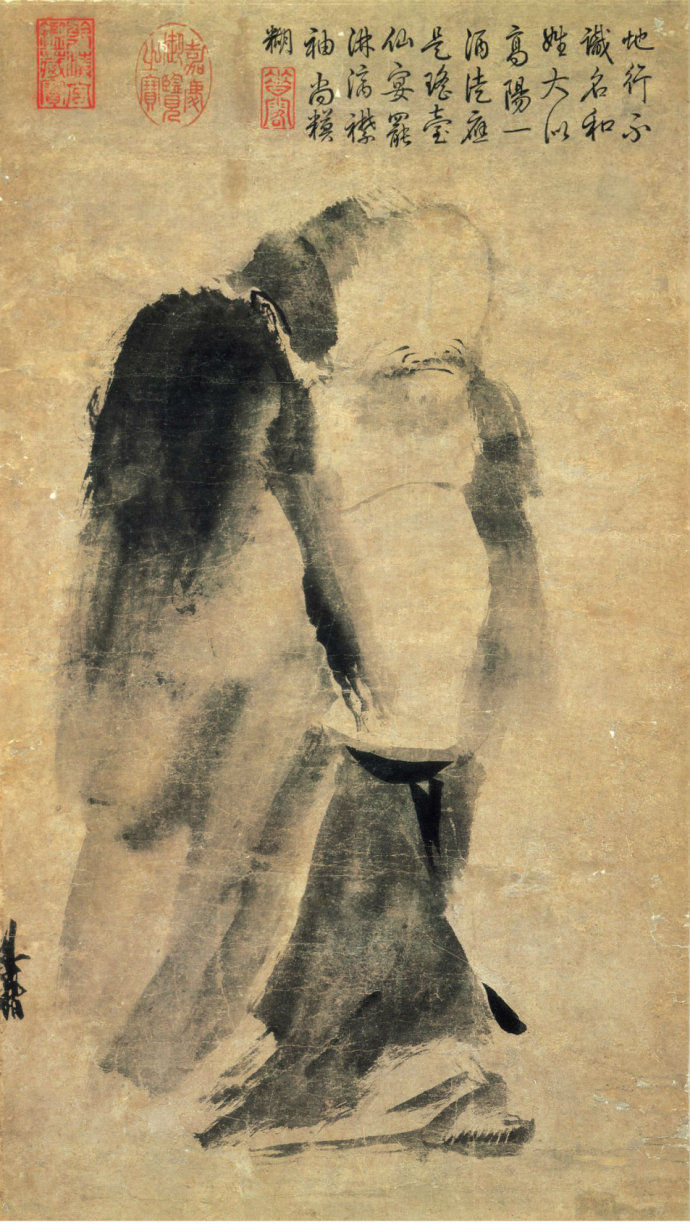
In a period, Wu's works had a certain connection with Jackson Pollock. In Chinese traditional painting, there is a technique called splash-ink, which is quite similar as the drip painting. However, the splash-ink is more caring about the blooming and mixing of water and ink on paper, so the brush is still contacting with the paper surface, and that is what Wu did in his abstract paintings.
His paintings usually depict the regions in the south of Yangtze River, which constructed with clear ink lines and some vibrant colours. The images are rich in the vitality of both human's life and nature, watery and simple, poetically delineate the feeling of Jiang-Nan (the south part of Yangtze River in Chinese)
The point that his works really inspired me is the use of water. The water balances black ink and creates diverse tones and feelings. It could be solid or dim, light or dark, the control of water significantly affects the texture of the ink.
1. Floating Clouds and Flowing Water
2. The Terrace
3. Suzhou Garden
4. Mirrored Heart
5. Impression of Sunrise
Mu Xin: The Other Shore

The last artist that I would like talk about is Mu Xin. Actually, it is more proper to call him as a poet or literator. I was profoundly enlightened by his Memoir of Literature at the age that also became interested on Buddhism and Taoism thought. It was one or two years later when I noticed that he did paint through the trailer of Dreaming Against The World (2015), a documentary about him. At that moment, I was astonished because most of his works are so small. They somewhat looked like Chinese landscape painting but still really different; nonetheless, a magnificent mood released from these pony-size pictures breathtakingly.
Mu Xin's transfer paintings are a bit similar as the paper marbling on the technique way, but how they looks like are quite complex. As for me, I only can say that they deeply impressed on my heart and I am amused and moved by the pictures.

Mu Xin rarely talked about his painting when he was alive, I could barely know more about them based on his student, Chen Danqing's words.

"This collection of paintings is horrible. As if the land of death, with the secludedness of non-human beings, opposite to the human world, or the opposite of painting (most landscape paintings are earthly, secular and beautiful). If they are beautiful, the reason is also because they are horrible: I don’t know how describe this kind of "horrible" - or can say "mystery", but I don't like this word: it is not "mysterious" and is overused - or another word, Mu Xin's so-called "the other side", as he said:'the shore, the crowd is bustling.'"
Chen Danqing

Mu Xin is special, because he grew up in a traditional Chinese family, which provided him an orthodox Chinese education that let him absorbed the classical culture and in his teenage time, he began to read Western literature. However, he was prisoned during the Cultural Revolution, and all his early works were burned. In 1982, he moved to New York and lived abroad until 2006, he finally back to his hometown in China when he was 79. Does not like Wu Guanzhong, who had already became extremely famous in China when he was alive, most of people started to know Mu Xin around or after he back to homeland in his twilight years.

He intentionally erased the Eastern and Western origin in his artworks. As he said, "I live on others and others live on me", his interest was in the world wide. Thus, we can perceive various taste in his works, which may refer to different culture's literature, poem and religion.

For this project, what his works mostly inspired me is the feeling. Although the scales of the picture are not as big as the traditional Chinese painting, they give a massive feeling in the mind. Chen described this as,"out of scale, non-scaled" and I agree with him, because the paintings can drag me into the picture and continually expanding out of the horizon. There is a magnificent manner in them.

Therefore, the scale of an artwork should not be decided by the physical scale, but how do the artist construct the feeling in the other shore.



Practice of Water, Ink and Paper
After researching different artists' works and trying to gain some ideas from them, eventually I was starting to experiment the technique. I was mainly interested in the external influence of the ink, such as water and paper.
There were three major types of Xuan paper, the paper that we traditionally used to paint the Chinese painting, which were untreated (raw), semi-treated (rare) and treated (ripe). The treated Xuan paper had an out-standing water-absorbing ability, so it was easy to create the effect of blooming. Therefore, I selected this kind of paper because the water and ink might produce a better texture on it.

Meanwhile, I added saline water into this experiment because the density of it can change the flow of ink and generate another effect.
In this process, I painted on two pieces of Xuan paper (138cm*69cm) and the topic was derived from a picture that I unconsciously drew in the summer of 2016. I wanted to draw the texture that as similar as the ripple or echo, that had many layers to express the change of ink.
From the experiment I found that the un- treated Xuan paper was rather difficult to control because the water would continue spreading and affect the other lines. Nonetheless, I was surprised by the effect of saline water. While it was contacting with the ink, the mixture immediately created a texture that a bit like snowflake. In conclusion, the type of paper still needed to change because I did not want the ink spread too much, but the saline water could be a nice material on some way.
The Idea
After the experiment, it is time to talk my main idea of the final outcome. On the basis of all the study that mentioned above, I prefer to focus on the "flow" firstly. The flow is a quite abstract word, and it reminds me both the water flow and the mind flow that I saw in many artists' works, such as Jackson Pollock, Wu Guanzhong and Mu Xin. Therefore, in the technique way, I would also pay more attention on the spiritual one, the abstract flow that wave through my mind while I am painting.
The origin of mind flow still need to derive from the perception of actual one. Naturally, I spread my mind to how did Roni Horn describes her Still water series, the water could be more subjective, becoming as the container of something, which changes its property. Water is no longer a common object, but like a story or a book that connecting with the people like Lao Zi and Confucius, who might also seen the analogous feature. The dialogue with the water would be the premise of painting with mind flow.
At that time, I was intrigued in a sentence written in the Diamond Sutra (Chapter 5):
"The Buddha then spoke to Subhuti: 'All that has a form is illusive and unreal. When you see that all forms are illusive and unreal, then you will begin to perceive your true Buddha nature.'"
Without any reason, this sentence just repeating in my mind. I would like to ask myself, "What is the illusion?"and "What is the Buddha?" again and again. Until one day when I was seating at Starbucks in an ancient town that near by my school, in a moment, I was staring at the watercourse that crossing the whole town. Maybe it was because I just read Hermann Hesse's Siddhartha, the water in the book really impressed in my heart; Somehow, I just felt that the water was strongly attracting me, let me carefully observe it, to see the water surface that reflected greyish-green colour. I noticed that, the light and shadow were gathered in the surface, the wind, created the wave and also separated the dark and light. Everything were flowing, the reflection of the trees, the people and the boats, their figures were twisted and became hard to identify in the water. Perhaps in another word, the forms implied their illusiveness on the water. After a while, I quickly took some pictures of the watercourse.

I always keen on black and white colour which was influenced by the Tai-Chi diagram in a certain extend. Thus, I converted the pictures into black-and-white, then increase the contrast between light and dark. There were some textures that I never noticed before appearing on the pictures.
In my opinion, the use of black and white in these pictures dissociated the connection of the other colours and the corresponding emotions that they may bring to me. These two colours established the calmness, allowing me to re-view the pictures and re-think about the "form" that mentioned on Buddha's saying. When the form was detached from its original colour and shape, somehow it revealed the unreal of the objects. They were easy to be changed, as same as the water that could effortlessly influenced by the wind. Although I knew that whenever a thing turns to a word or an object, it would not fit with what Buddha said, because it was still restricted as a form. However, the pictures had given me a sense of that sentence, and inspired me how to paint out my thought.
Painting Process
Finally, I selected two pieces of watercolour paper, a Chinese brush and a bottle of middle consistency Chinese ink as the materials, because I wanted to keep the texture that the photos gave me and avoid showing too much property of water with adding saline water or water into it. The watercolour paper effectively absorbed the ink and kept explicit boundary line between black and white area. Besides, the scale was inspired by Mu Xin, I also used a long scale format to paint.

I mixed many eyes and human's faces in the painting because I thought every form in the end will be turned into the form of ourselves. Through the water, what we see is not only the reflection of the objects, but more is the reflection of the mind. The shadows were abstractly waving on the water, the so-called pattern, texture and shape were barely the flow in our heart. The black part was based on the actual shadow on the water, but gradually blended into my mind flow, and subsequently transit to the full mind flow.
Illusiveness 虚妄
Statement
The wind can changed the wave of water. Light and darkness produced a twisted shadow on the wave. The water flows through the river and finally comes into my heart. Buddha told Subhuti that the true Buddha only would be perceived while you realising the illusiveness of forms. The wind, the wave and the shadow are illusive, and same as that flow in the heart.





























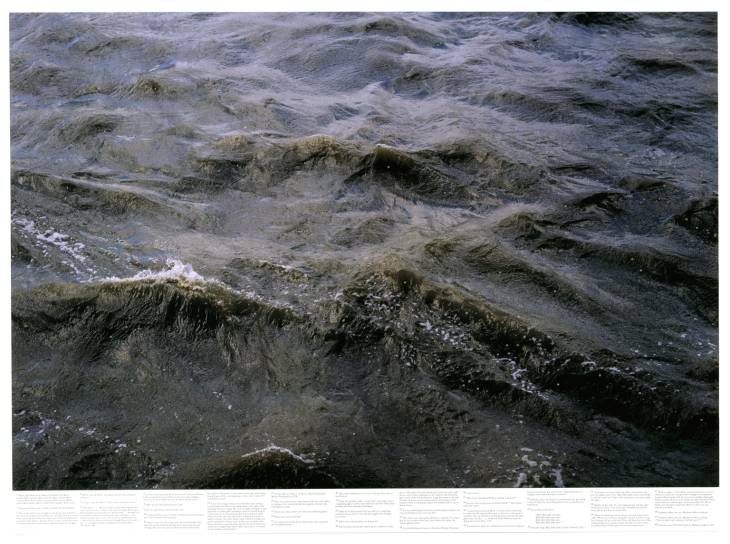







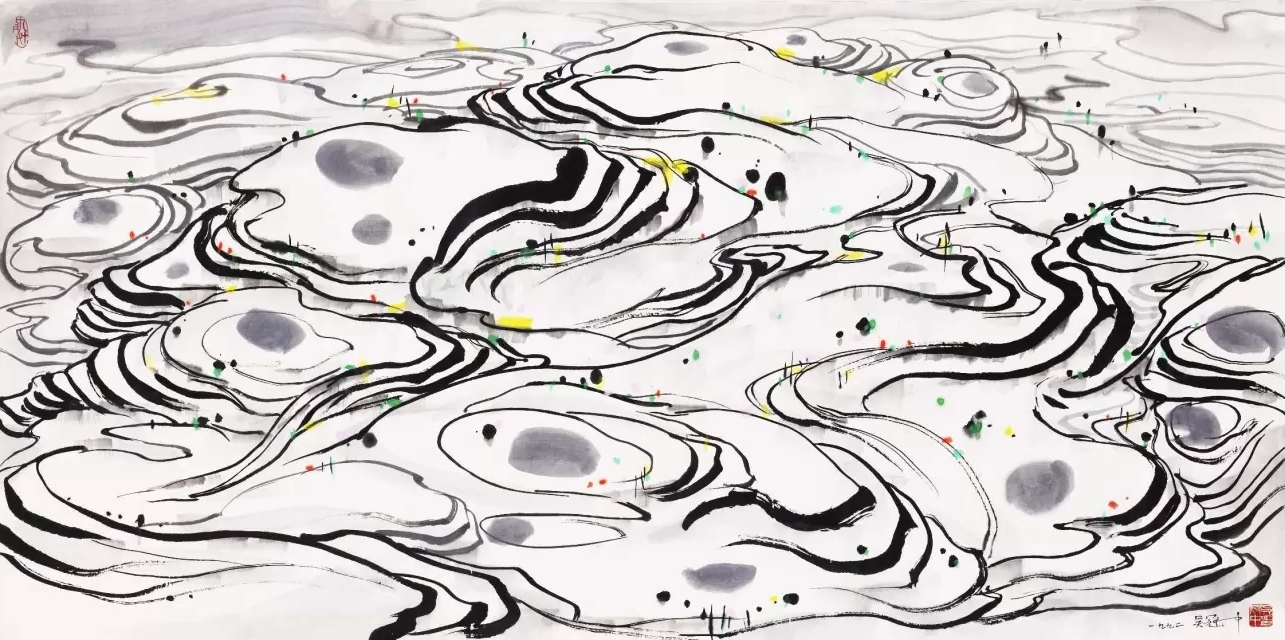



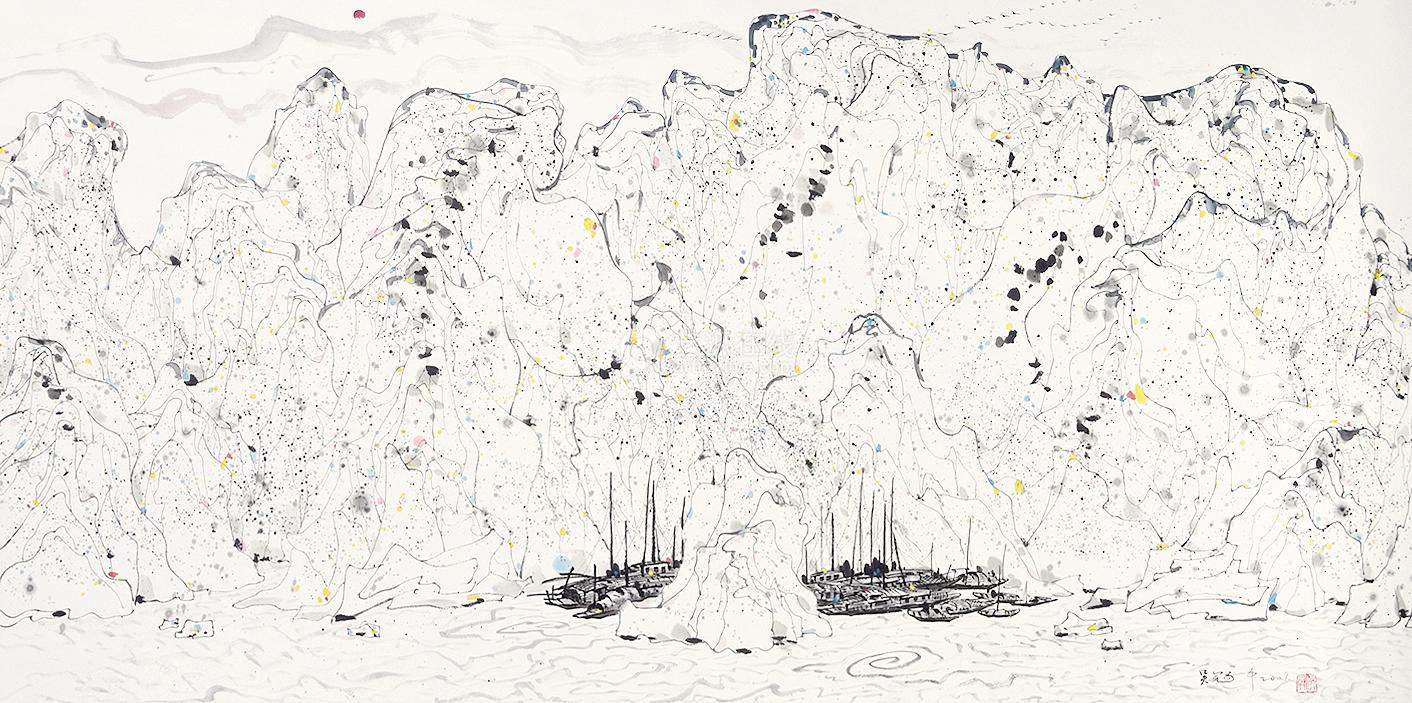

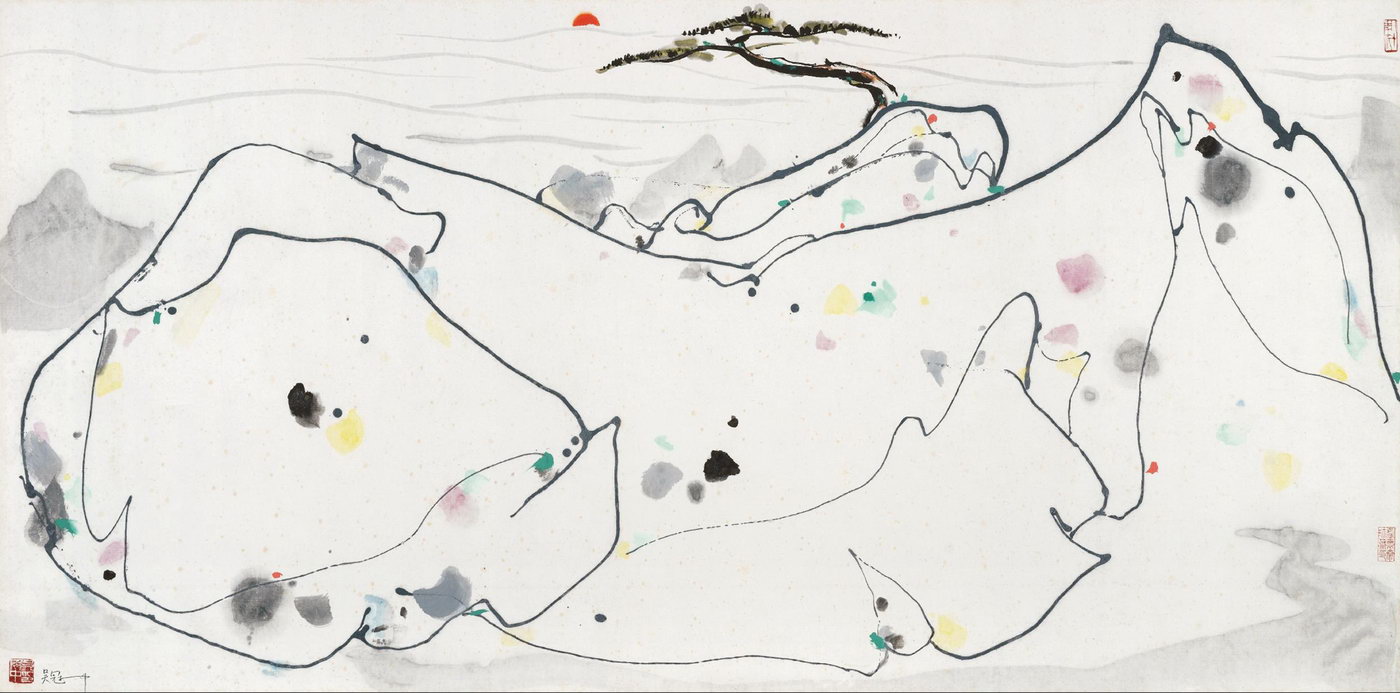


















Comments